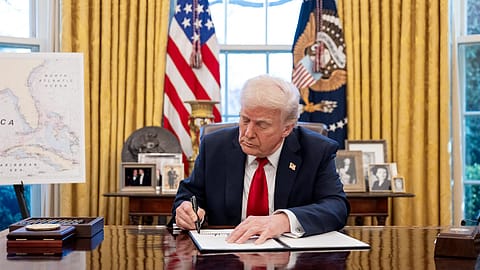U.S. Supreme Court to examine legal validity of Trump tariff; outcome could influence India-US FTA talks
The law under which Trump imposed these tariffs—now being challenged in the Supreme Court—is the International Emergency Economic Powers Act (IEEPA), a US national security law enacted in 1977.

Today, the Supreme Court of the United States (U.S.) begins hearing a case of global interest, the outcome of which could have a direct impact on India’s ongoing negotiations for a bilateral free trade agreement (FTA) with that country. Experts say it could also prompt some nations to re-examine the recent FTAs they have signed with the US.
The petition before the Supreme Court that has generated such interest challenges the legality of US President Donald Trump’s sweeping reciprocal tariffs, which shook the global trade order in recent months.
On April 2, 2025, President Trump imposed 10% reciprocal tariffs on nearly all imports (as high as 50% on some countries, including India) citing the US trade deficit and import dependence as a national emergency.
Trump argued that decades of trade deficits had weakened the country’s industrial base and posed an economic threat, necessitating such harsh tariff measures to restore balance. The FTA negotiations that followed used this tariff threat as a key bargaining tool to extract deals favouring the US from some of its trade partners. The India-US FTA negotiations are still ongoing.
The law under which Trump imposed these tariffs—now being challenged in the Supreme Court—is the International Emergency Economic Powers Act (IEEPA), a US national security law enacted in 1977.
“The IEEPA was originally crafted to let presidents restrict financial or property transactions with hostile foreign powers—not to impose general tariffs. Still, the US administration relied on it to impose tariffs and collect an estimated $100 billion in new customs revenue,” says trade expert Ajay Srivastava.
He also pointed out that three lower courts have already ruled against the Trump administration, prompting the government to appeal before the Supreme Court.
Recommended Stories
The case was first heard in the US District Court for the Northern District of Illinois, which on April 26, 2025, rejected the government’s argument that IEEPA allowed broad tariff powers and referred the matter to the trade courts. Similarly, the US Court of International Trade (CIT), in a June 14, 2025, decision, held that IEEPA does not authorize the president to levy general tariffs and that Trump’s use of emergency powers for routine trade matters violated the Constitution’s separation of powers.
A third adverse ruling for the Trump administration came from the US Court of Appeals for the Federal Circuit, which upheld that decision on August 2, 2025, finding that Congress had never delegated such sweeping authority to the executive branch.
The two core issues before the Supreme Court now concern jurisdiction and presidential power related to Trump’s tariff actions.
“The first question is whether the case belongs in a federal district court or the Court of International Trade. The petitioners—small importers led by Learning Resources, Inc.—argue that their claims arise under IEEPA itself, not under any law ‘providing for tariffs,’ and therefore should be heard in a district court. The government maintains that because the case challenges the tariff schedule, it properly falls under the CIT’s jurisdiction,” Srivastava explains.
“The second and more consequential issue is whether IEEPA allows the president to impose tariffs at all. The petitioners, represented by Akin Gump Strauss Hauer & Feld LLP, argue that the law’s language permitting regulation of ‘importation or exportation’ does not extend to setting customs duties—a power reserved for Congress. They invoke the ‘major questions doctrine,’ arguing that allowing a president to declare economic emergencies and unilaterally set tariffs would upset the constitutional balance of powers,” he adds.
If the Supreme Court rules against Trump, it could force the administration to withdraw the tariffs imposed under IEEPA. Such a ruling would mean all tariffs—and subsequent rate hikes—would have to be rolled back or face injunctions halting their collection.
The decision could unravel the foundation of several recently negotiated trade arrangements with key partners such as the EU, Japan, South Korea, and the UK, all of which were struck under the shadow of those tariffs and premised on reciprocal concessions. It would also disrupt ongoing FTA talks with India and prompt a recalibration of the US export strategy by Indian exporters.